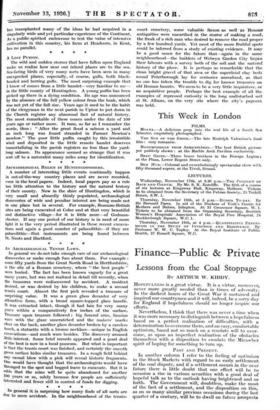AN ARCHAEOLOGICAL TENNIS LAWN.
In general we do not take enough care of our archaeological discoveries or make enough fuss about them. For example : some fifty yards from the Great North Road in Hertfordshire, is the site of a Roman cemetery, where " the best people " were buried. The fact has been known vaguely for a great many years, but was not realized in detail till recently, when the treasures were rediscovered by accident. A resident desired, or was desired by his children, to make a second tennis court. Almost the first pick revealed a treasure of surprising value. It was a green glass decanter of very attractive form, with a broad square-topped glass handle. It was extracted intact, though it had lain for very many years within a comparatively few inches of the surface. Treasure upon treasure followed : big, funeral urns, Saurian ware with the glaze unscratched and the makers' marks clear on the back, another glass decanter broken by a careless touch, a statuette with a bronze necklace—unique in English excavations—and much ware besides. The discovery aroused little interest. Some brief records appeared and a good deal of the best is now in a local museum. But what is important is that the tennis court was finished, and certainly the smooth green surface hides similar treasures. In a rough field behind ally casual blow with a pick will reveal historic fragments. One would have thought that the archaeologists would have thronged to the spot and begged leave to excavate. But it is odds that the mine will be quite abandoned for another 100 years or so, solely because few people arc sufficiently interested and fewer still in control of funds for digging.
• * * *
In general it is surprising how many fords of all sorts are due to mere accident. In the neighbourhood of the tennis- court cemetery, some valuable Saxon as well as Rornate antiquities were unearthed in the course of making a road, the freak of a rich man who desired to remove the road proper by a few hundred yards. Yet most of the more fruitful spots could be inferred from a study of existing evidence. It may be a good omen for the future that—again in the same neighbourhood—the builders of Welwyn Garden City began their labours with a survey both of the soil and the natural* history of the place. It is perhaps as remarkable that the clean bright gravel of that area or the superficial clay beds round Peterborough lay for centuries unrealized, as that no one has taken the trouble to dig for known treasures on old Roman haunts. We seem to be a very little inquisitive, or an acquisitive people. Perhaps the best example of all the examples of repressed curiosity is the long undisturbed soil at St. Albans, on the very site where the city's pageant was held.














































 Previous page
Previous page